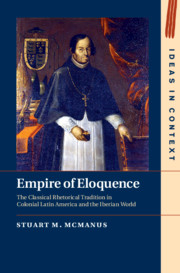 Empire of Eloquence
Empire of Eloquence Published online by Cambridge University Press: 09 April 2021
Chapter 3 argues that the classical rhetorical tradition was a powerful tool for both European and non-European Jesuit missionaries seeking to advance the cause of Iberianized Catholicism. To do so, it places the Jesuit spiritual conquest of the Americas within the context of the Society of Jesus’ parallel efforts in Asia. More precisely, it follows the career of a Japanese Jesuit, Hara Martinho (c. 1568–1629), from his early education in the Jesuit college at Arima in Japan, to his participation in the Tenshō Embassy to Rome and finally to the crowning achievement of his humanist career, the delivery of his Latin panegyric oration to his fellow Jesuit students at Goa. While no Jesuit sermons in Japanese survive, there are several surviving Chinese sermons, which reveal that the classical rhetorical tradition could influence public speaking in East Asian languages. When taken as a whole, the case of this Japanese Cicero shows that the classical rhetorical tradition in its Renaissance humanist garb was a valuable weapon for Jesuit missionaries seeking to expand the boundaries of Catholicism in a much more militaristic way than most recent scholarship suggests.
To save this book to your Kindle, first ensure [email protected] is added to your Approved Personal Document E-mail List under your Personal Document Settings on the Manage Your Content and Devices page of your Amazon account. Then enter the ‘name’ part of your Kindle email address below. Find out more about saving to your Kindle.
Note you can select to save to either the @free.kindle.com or @kindle.com variations. ‘@free.kindle.com’ emails are free but can only be saved to your device when it is connected to wi-fi. ‘@kindle.com’ emails can be delivered even when you are not connected to wi-fi, but note that service fees apply.
Find out more about the Kindle Personal Document Service.
To save content items to your account, please confirm that you agree to abide by our usage policies. If this is the first time you use this feature, you will be asked to authorise Cambridge Core to connect with your account. Find out more about saving content to Dropbox.
To save content items to your account, please confirm that you agree to abide by our usage policies. If this is the first time you use this feature, you will be asked to authorise Cambridge Core to connect with your account. Find out more about saving content to Google Drive.